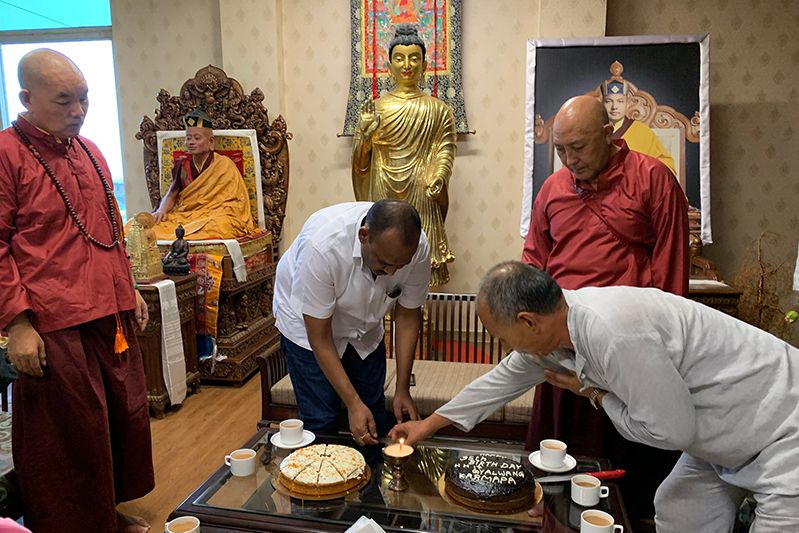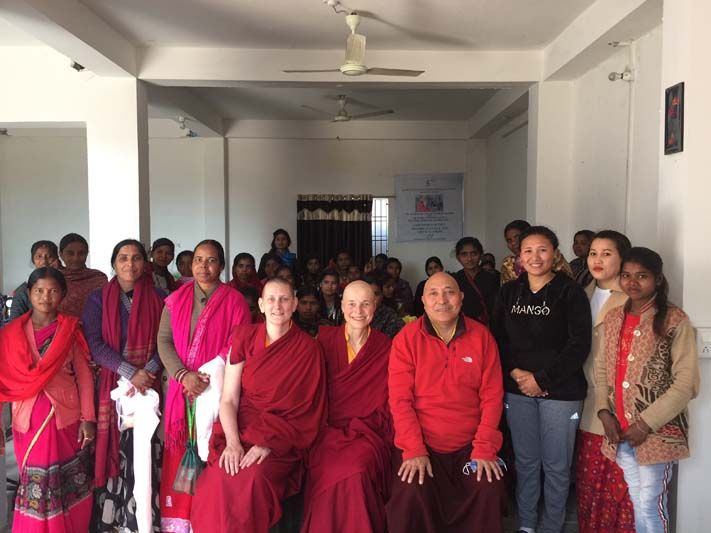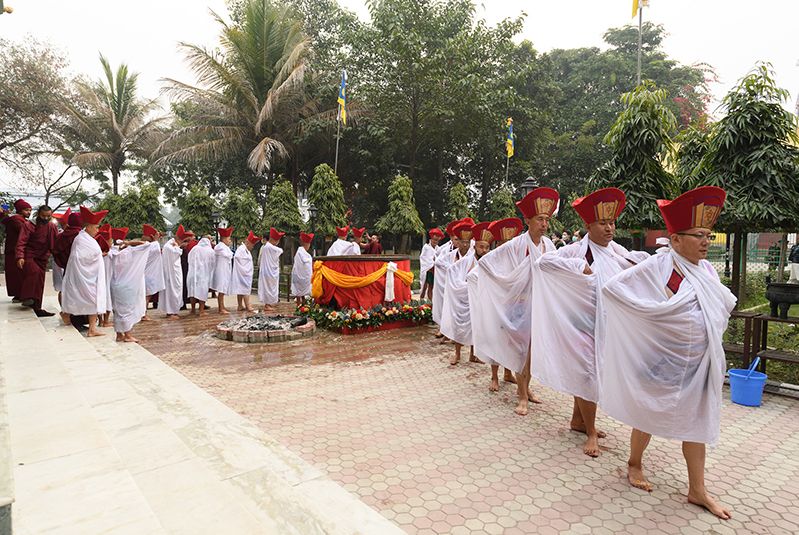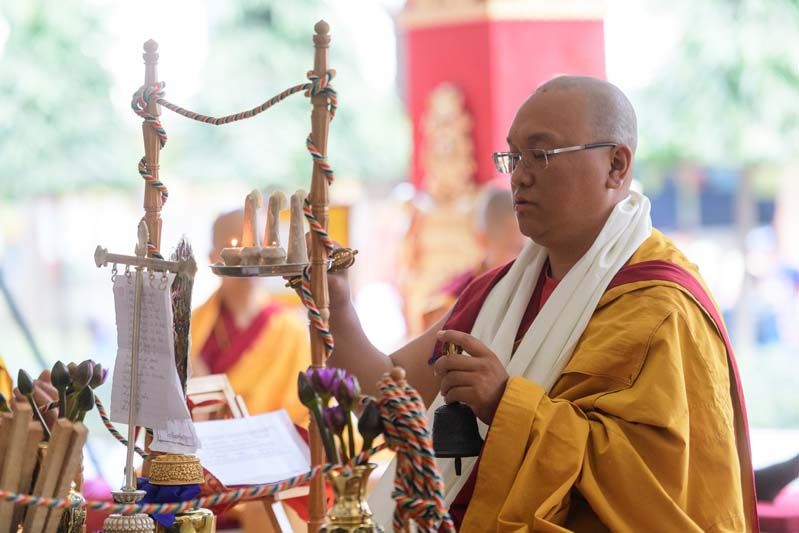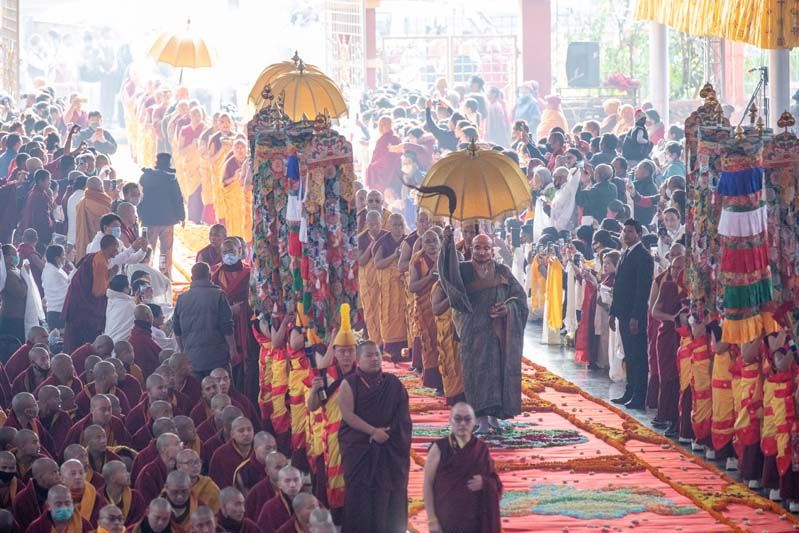A Talk on the Relationship between Masters and Disciples
- January 4, 2009
January 04, 2009, By 17th Gyalwang Karmapa - Translated by Tyler Dewar, Karma Choephel, and Ven. Lhundup Damchö for Monlam English Translation Network.
While Milarepa was training under lord Marpa, Marpa gave Milarepa nothing but a hard time in the beginning. For a long time Marpa did not grant him empowerments or instructions. During that time, Milarepa did not lose even the tiniest bit of trust in his guru, though on many occasions he did become somewhat discouraged.
We disciples who follow in the footsteps of the victorious forebears of our lineage are here today to practice. From that perspective, I thought it would be good if during this session, I spoke briefly on the guru-disciple relationship in connection with the beginning of the Kagyu Monlam.
Also, we have expanded a number of the features of the site where we are holding the twenty-sixth Kagyu Monlam, including the main gates and so forth, and I thought it would be good to briefly point out what the tormas represent. The main decorative tormas are those with images of Marpa, Milarepa, and Gampopa on the right, and on the left, those with images of the forebears of the Nyingma school of the early translations, the glorious Sakya lineage, and the Gelukpa order.
The main principle these tormas illustrate is that when we consider the Tibetan Buddhist teachings, there are basically no lineages that are not mixed with the others. When the three Dharma kings Songsten Gampo, Trisong Deutsen, and Tri Ralpachen first established the Dharma in Tibet, the lineage that emerged at that time became known as the “Nyingma school of secret mantra.” Thus the Nyingma was Tibet’s first Buddhist lineage. Later on, during the reign of King Langdarma, the teachings were wiped out of Tibet, and the later propagation of the teachings began. That is the difference between the Nyingma and Sarma vajrayana schools.
Then the oral lineage of the Kadampa masters was passed down from the glorious Atisha, and the Sakya, Kagyu, and Geluk lineages successively appeared. The stages of the teachings of all of these lineages, along with their basic starting points, are the same. The different individual lineages arose out of different lineages of lamas and instructions, but fundamentally there is not even a single lineage that is not mixed with the others. In sum, all Tibetan lineages have been passed down intermingled with the others—all of them share Dharma connections and connections of samaya.
There have sometimes been some minor incidents between the lineages because of each lineage’s different way of acting and different placement of emphasis. Some people who don’t understand practice might have occasionally found such differences discomfitting, because of which various minor incidents have occurred. But as Lama Marpa said, when he put Milarepa through innumerable, unthinkable hardships, although an ordinary person might think at first glance that he was showing Milarepa absolutely no compassion, what was actually happening was that Marpa was acting in this way so that Milarepa could purify his negative actions and obscurations. It is clear that Marpa was not behaving in this way for his own private good or without any reason or purpose.
Thus if we take such accounts as an example, in the long history of the Dharma lineages of Tibet that have survived to this day without excluding any, a few lamas have displayed different sorts of activities and life examples. Ordinary people who do not understand the Dharma might perhaps look at these various acts and get the wrong impression, lose faith, and develop misconceptions. But there is nothing that would allow one to say that such activity was in its essence inconsistent with or contradictory to the Dharma.
Therefore the presence of images of the root and lineage gurus from all of the Tibetan Buddhist lineages here today means that all Tibetan Buddhist lineages are nothing other than the teachings of the Buddha: They are all the same. For instance, it is like the eighteen schools of early Buddhism. All eighteen schools were the same in being the Buddha’s teaching, as affirmed by the account of the prophecy from King Krikin’s dream. Similarly, it is very important for each of us to be able to consider this and think about it. I think that only when that happens will we be able to remain in harmony with our samaya to our root and lineage lamas without contradicting or breaking it. It is important for all of us to stretch our minds in this direction.
Another important point is that it is insufficient to think of the “guru-disciple relationship” only in terms of the teachers we have directly met and made a connection with, without considering other gurus. There are many kinds of gurus, such as root and lineage gurus. Therefore we need to broaden our view of what we mean when speaking of “gurus.” We cannot just consider those teachers we have met and seen with our own eyes in this lifetime to be genuine teachers, while pretending not to know of any other teachers at all. Whenever we recite a meditation liturgy, even a short one, we always begin with a supplication to each of the lineage gurus from Buddha Vajradhara down from one lama to another all the way to our own root guru. It is very important for us to reflect on what the need to value the lineage lamas and recite their names is actually about.
Within our lineages, there have been many great, genuine masters of all sects, and we meditate on them as the field of merit present as a line of crown jewels at the pinnacle of our lineage. But if we cannot bring them to mind at other times when we are actually endeavoring to benefit beings and the teachings, then meditating on the field of merit itself is meaningless. Just as we visualize vibrant images of the lineage lamas in the field of merit when we meditate, when we work to perform benefit for beings and the teachings we must be able to remember the kindness of our root and lineage gurus and emulate their life examples. If we think it is basically sufficient to merely keep ourselves in line with the commands and views of our monastery’s main teacher, perhaps we are not really thinking about the teachings themselves. Perhaps we are only thinking about our own food and clothing.
The master of our own monastery is the one who kindly supports us with food and clothing. If we only focus on taking his side and supporting whatever he does or says, we will not be able to think expansively and in harmony with the general themes of the Dharma as a whole. Eventually it will be as if the vibrant square shape of the Buddhist teachings has been shattered into many different fragments and we will be unable to point to anything and say, “That’s the teaching of the Buddha.” We will find fault with everything and only have misconceptions. Thus, just as we know how to say the words “root and lineage lamas,” it is very important for us to know what those words mean.
We should have faith, interest, and trust in all the root and lineage gurus, adopting a posture of being a disciple of each of them. With this sense of well-grounded faith, whatever activities of practice and study we may engage in, they will be in harmony with the Dharma, and we will meet all the characteristics of a genuine student of the gurus. Without this faith, things will be very difficult for us. This is the reason why the gurus of the lineages are depicted on the tormas we have here. Their images are not there solely to decorate or show off to people: These tormas were made in order to help us remember the kindness of our genuine root and lineage gurus. When we see these tormas, we should remember these gurus’ kindness, and we should reflect on how difficult it would have been for us, without these gurus, to have entered the gateway of the precious teachings of the Buddha and to have an opportunity to benefit sentient beings, free from bias. It is very important that we all think about this.
We need to study the life stories of Marpa and Milarepa that I was just reading aloud, but it is not enough just to read the books: We must reflect on their meaning and engage in the practices following these masters’ life examples, and find some method by which we can apply these teachings in an immediate way in our lives. Otherwise there would be no purpose in reading the life story of Milarepa here. We would be better off studying philosophical texts or learning more about the mind training teachings instead.
The reason why I feel I absolutely must give this transmission of The Life of Milarepa is that we can get a feeling of the practice that an authentic being actually did in his own life. We can get a feeling of being able to make an intimate human connection as if we could take his hand. There are of course many other biographies of inconceivable masters, such as those of the buddhas and bodhisattvas. But ordinary people cannot even get their minds around those life stories, much less put them into practice. Yet with Milarepa, we have the story of how he started out as a completely ordinary person and committed serious wrongs, but in the end accomplished the genuine Dharma with whole-hearted commitment. I think it is the story of such an authentic master that it stays in our minds and moves our hearts.
While Milarepa was training under lord Marpa, Marpa gave Milarepa nothing but a hard time in the beginning. For a long time Marpa did not grant him empowerments or instructions. During that time, Milarepa did not lose even the tiniest bit of trust in his guru, though on many occasions he did become somewhat discouraged.
We disciples who follow in the footsteps of the victorious forebears of our lineage are here today to practice. From that perspective, I thought it would be good if during this session, I spoke briefly on the guru-disciple relationship in connection with the beginning of the Kagyu Monlam.
Also, we have expanded a number of the features of the site where we are holding the twenty-sixth Kagyu Monlam, including the main gates and so forth, and I thought it would be good to briefly point out what the tormas represent. The main decorative tormas are those with images of Marpa, Milarepa, and Gampopa on the right, and on the left, those with images of the forebears of the Nyingma school of the early translations, the glorious Sakya lineage, and the Gelukpa order.
The main principle these tormas illustrate is that when we consider the Tibetan Buddhist teachings, there are basically no lineages that are not mixed with the others. When the three Dharma kings Songsten Gampo, Trisong Deutsen, and Tri Ralpachen first established the Dharma in Tibet, the lineage that emerged at that time became known as the “Nyingma school of secret mantra.” Thus the Nyingma was Tibet’s first Buddhist lineage. Later on, during the reign of King Langdarma, the teachings were wiped out of Tibet, and the later propagation of the teachings began. That is the difference between the Nyingma and Sarma vajrayana schools.
Then the oral lineage of the Kadampa masters was passed down from the glorious Atisha, and the Sakya, Kagyu, and Geluk lineages successively appeared. The stages of the teachings of all of these lineages, along with their basic starting points, are the same. The different individual lineages arose out of different lineages of lamas and instructions, but fundamentally there is not even a single lineage that is not mixed with the others. In sum, all Tibetan lineages have been passed down intermingled with the others—all of them share Dharma connections and connections of samaya.
There have sometimes been some minor incidents between the lineages because of each lineage’s different way of acting and different placement of emphasis. Some people who don’t understand practice might have occasionally found such differences discomfitting, because of which various minor incidents have occurred. But as Lama Marpa said, when he put Milarepa through innumerable, unthinkable hardships, although an ordinary person might think at first glance that he was showing Milarepa absolutely no compassion, what was actually happening was that Marpa was acting in this way so that Milarepa could purify his negative actions and obscurations. It is clear that Marpa was not behaving in this way for his own private good or without any reason or purpose.
Thus if we take such accounts as an example, in the long history of the Dharma lineages of Tibet that have survived to this day without excluding any, a few lamas have displayed different sorts of activities and life examples. Ordinary people who do not understand the Dharma might perhaps look at these various acts and get the wrong impression, lose faith, and develop misconceptions. But there is nothing that would allow one to say that such activity was in its essence inconsistent with or contradictory to the Dharma.
Therefore the presence of images of the root and lineage gurus from all of the Tibetan Buddhist lineages here today means that all Tibetan Buddhist lineages are nothing other than the teachings of the Buddha: They are all the same. For instance, it is like the eighteen schools of early Buddhism. All eighteen schools were the same in being the Buddha’s teaching, as affirmed by the account of the prophecy from King Krikin’s dream. Similarly, it is very important for each of us to be able to consider this and think about it. I think that only when that happens will we be able to remain in harmony with our samaya to our root and lineage lamas without contradicting or breaking it. It is important for all of us to stretch our minds in this direction.
Another important point is that it is insufficient to think of the “guru-disciple relationship” only in terms of the teachers we have directly met and made a connection with, without considering other gurus. There are many kinds of gurus, such as root and lineage gurus. Therefore we need to broaden our view of what we mean when speaking of “gurus.” We cannot just consider those teachers we have met and seen with our own eyes in this lifetime to be genuine teachers, while pretending not to know of any other teachers at all. Whenever we recite a meditation liturgy, even a short one, we always begin with a supplication to each of the lineage gurus from Buddha Vajradhara down from one lama to another all the way to our own root guru. It is very important for us to reflect on what the need to value the lineage lamas and recite their names is actually about.
Within our lineages, there have been many great, genuine masters of all sects, and we meditate on them as the field of merit present as a line of crown jewels at the pinnacle of our lineage. But if we cannot bring them to mind at other times when we are actually endeavoring to benefit beings and the teachings, then meditating on the field of merit itself is meaningless. Just as we visualize vibrant images of the lineage lamas in the field of merit when we meditate, when we work to perform benefit for beings and the teachings we must be able to remember the kindness of our root and lineage gurus and emulate their life examples. If we think it is basically sufficient to merely keep ourselves in line with the commands and views of our monastery’s main teacher, perhaps we are not really thinking about the teachings themselves. Perhaps we are only thinking about our own food and clothing.
The master of our own monastery is the one who kindly supports us with food and clothing. If we only focus on taking his side and supporting whatever he does or says, we will not be able to think expansively and in harmony with the general themes of the Dharma as a whole. Eventually it will be as if the vibrant square shape of the Buddhist teachings has been shattered into many different fragments and we will be unable to point to anything and say, “That’s the teaching of the Buddha.” We will find fault with everything and only have misconceptions. Thus, just as we know how to say the words “root and lineage lamas,” it is very important for us to know what those words mean.
We should have faith, interest, and trust in all the root and lineage gurus, adopting a posture of being a disciple of each of them. With this sense of well-grounded faith, whatever activities of practice and study we may engage in, they will be in harmony with the Dharma, and we will meet all the characteristics of a genuine student of the gurus. Without this faith, things will be very difficult for us. This is the reason why the gurus of the lineages are depicted on the tormas we have here. Their images are not there solely to decorate or show off to people: These tormas were made in order to help us remember the kindness of our genuine root and lineage gurus. When we see these tormas, we should remember these gurus’ kindness, and we should reflect on how difficult it would have been for us, without these gurus, to have entered the gateway of the precious teachings of the Buddha and to have an opportunity to benefit sentient beings, free from bias. It is very important that we all think about this.
We need to study the life stories of Marpa and Milarepa that I was just reading aloud, but it is not enough just to read the books: We must reflect on their meaning and engage in the practices following these masters’ life examples, and find some method by which we can apply these teachings in an immediate way in our lives. Otherwise there would be no purpose in reading the life story of Milarepa here. We would be better off studying philosophical texts or learning more about the mind training teachings instead.
The reason why I feel I absolutely must give this transmission of The Life of Milarepa is that we can get a feeling of the practice that an authentic being actually did in his own life. We can get a feeling of being able to make an intimate human connection as if we could take his hand. There are of course many other biographies of inconceivable masters, such as those of the buddhas and bodhisattvas. But ordinary people cannot even get their minds around those life stories, much less put them into practice. Yet with Milarepa, we have the story of how he started out as a completely ordinary person and committed serious wrongs, but in the end accomplished the genuine Dharma with whole-hearted commitment. I think it is the story of such an authentic master that it stays in our minds and moves our hearts.
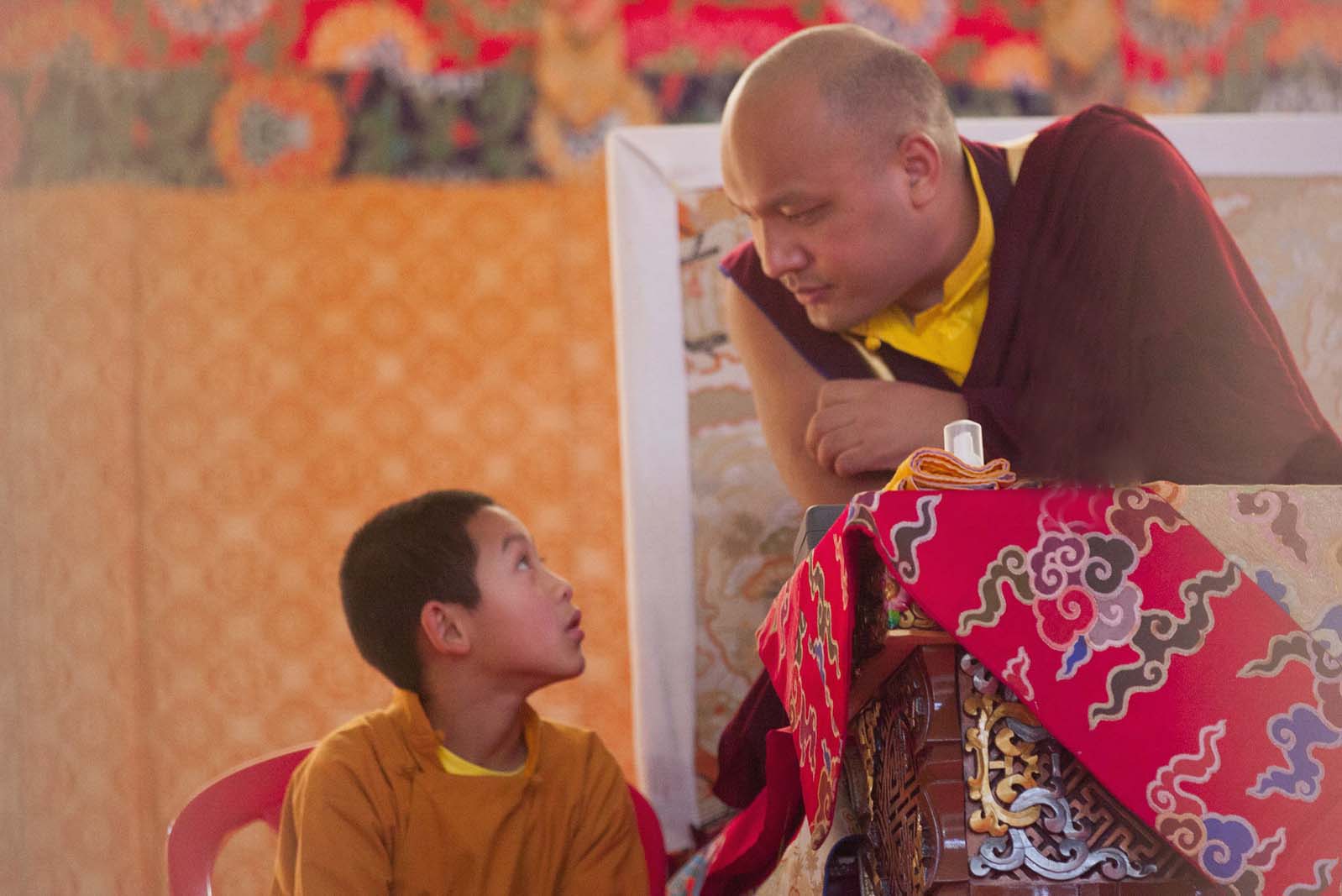
37th Kagyu Monlam Schedule
Tibetan / English / Chinese • French • German • Indonesian • Korean • Polish • Russian • Spanish • Vietnamese
Dharma Teachings
 Meditation Instructions
Meditation Instructions
Recorded during the 37th Kagyu Monlam, Bodhgaya, India. January 28-30, 2020.

